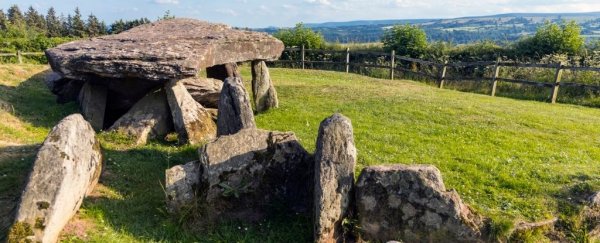Archaeologists have finally figured out how Arthur's Stone, the famous Neolithic monument in Herefordshire, UK that inspired the 'stone table' in The Chronicles of Narnia, came to be.
Ever since the large quartz conglomerate of rocks was first assembled – sometime around 3,700 BCE – this double-chambered tomb has remained a mysterious beacon of the past.
In that entire time, the highly protected heritage site has never been directly excavated, which means we know very little about how it was first built. Other similar sites in the region, found with skeletons, suggest it is probably a tomb of some sort.
There are many places in the United Kingdom and beyond associated with the legend of King Arthur (there's even another Arthur's Stone in Wales, also known as Maen Ceti). According to mythology, the stone slab in Herefordshire is where Arthur once slew a giant, who left an impression in the stones as he fell.
Yet apart from myths and legends, historians and archaeologists have had little else to work with. Now, the first proper excavations slightly to the south of the monument have revealed a different story – one that extends far beyond a single lonely hillside.
The initial findings by researchers from the University of Cardiff and the University of Manchester, yet to be published in a peer-reviewed journal, suggest Arthur's Stone was once part of a much larger ceremonial landscape.
When the tomb was first built, archaeologists say it was probably covered in a mound of compressed turf, with a series of posts to hold it in place. This long mound stretched into the nearby field, but rot caused it to collapse over time.
The mound was then rebuilt with a slightly different orientation.
While archaeologists say the second structure pointed to an area between Skirrid Hill and Garway Hill, the first mound likely faced Dorstone Hill.
In 2013, the hillside of Dorstone was also discovered to house three similar burial mounds, containing two 'halls of the dead', built roughly 6,000 years ago.
The date, structure, and orientation of Arthur's Stone suggest these two hillside sites were closely connected.
"Each of these three turf mounds had been built on the footprint of a large timber building that had been deliberately burnt down," says archaeologist Julian Thomas from the University of Manchester.
"Indeed, the block of upland between the Golden Valley and the Wye Valley is now becoming revealed as hosting an integrated Neolithic ceremonial landscape."
Arthur's Stone is not the only odd stacking of rocks found in the United Kingdom, but it's probably among the most famous. While the site looks like a lot of effort to build, its appearance is somewhat deceiving.
Instead of stacking these large stones on top of one another, the ground underneath the main rock was probably dug out to allow supporting rocks to slide underneath.
A long mound of dirt was then added over the top, extending all the way into the field to the south, which is where the recent excavations occurred.
What's left today is probably only a fraction of what once existed.
"Although Arthur's Stone is an iconic Megalithic monument of international importance, its origins had been unclear until now," says Thomas.
"Being able to shine a light on this astonishing 5,700-year-old tomb is exciting, and helps to tell the story of our origins."
The results from the recent excavations have yet to be published.
Editor's note (3 Sept 2021): A previous version of this article contained details conflating this particular Arthur's Stone in Herefordshire with Maen Ceti in Wales. We regret the error and have corrected the article accordingly.
